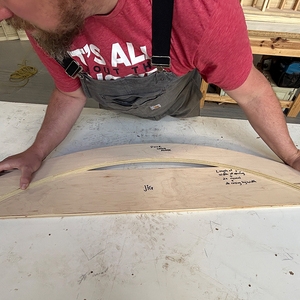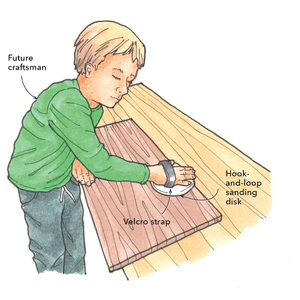Guys; Would like to put the range exhaust fan on an inside wall. Which means I have to run a horizontal section of vent about 7′ long before it exits under the eaves. Is this ok or should I put it on the outside wall? Should have just one 90 deg. turn.
The remodel I am doing would look much better with the range on the inside wall, the range looks much better in this location than the refrigerator. If I have to I can put the range on the outside wall.



















Replies
Get a ventless.
Gunner; What brand would be a decent one? I never knew they made one . Where the heck does the vented air, smoke ,smells etc. go? Thanks!
NuTone is the one I have. There's a filter in the bottom that takes care of the greases and such. I have a stove on an interior wall so I have the same situation and like the fact that I don't have to vent.
Bob,I've never come close to gasing myself out. If your gas stove emites that much gas odor you need to sue the installer. Besides your house would blow up if you had fumes.
I hear of CO detectors going off in kitchens without vented gas ranges. I don't have any idea if the CO levels are high enough that someone should be concerned, though come to think of it who has ever heard of anyone getting knocked unconscious by kitchen fumes.
"I hear of CO detectors going off in kitchens without vented gas ranges. I don't have any idea if the CO levels are high enough that someone should be concerned"
If the alarm is going off, there is a problem.
", though come to think of it who has ever heard of anyone getting knocked unconscious by kitchen fumes."
I have. CO poisoning from stoves is fairly common. Plus, becoming unconscious is NOT the only possible effect of serious CO poisoning. Please see my other post.
BTW, CO is an issue that I have studied in depth.
Edited 6/17/2002 1:28:41 PM ET by Bob Walker
You make a good point, but of all the houses I wired while doing residential only one bothered to vent their stove with duct. So I really don't worry about it. Maybe when I fall over dead making eggs in the morning I might rethink the self venting stove. But then again it might be cholesteral.
" Maybe when I fall over dead making eggs in the morning I might rethink the self venting stove"
So, your stove doesn't produce significant amounts of CO. I guess that proves none of them do, right?
Most of the furnaces and water heaters I test don't produce significant amounts of CO either. (Usually they produce far less than the stoves!) So, I guess we really don't need to vent them either, based on your analysis, right?
Edited 6/18/2002 3:31:53 PM ET by Bob Walker
Bob
Here is a good article on kitchens ovens and CO.
http://hem.dis.anl.gov/eehem/95/950907.html#95090736
Even if the hood doen't vent, wouldn't it help keep the cabinets from catching fire if something flamed up on oven?
Bill,
Thanks. Very good article!
Thanks guys! I appreciate the help!
Gnarly; i think my cabinets might look better if they did catch on fire. i should have the new ones made in a month or so.
Gunner; I would have to agree that if you have LP or natural gas vapors then you have some other serious problems that will need more than a fan. thanks for the info gunner. I will search the internet and do some homework on the ventless type.
"Bob,I've never come close to gasing myself out."
How do you know? CO poisoning is believed to be one of the most commonly missed diagnoses in emergency rooms. CO cannot be detecetd by any of our 5 senses.
" If your gas stove emites that much gas odor you need to sue the installer. Besides your house would blow up if you had fumes."
In the mean time, you could well have suffered some long term serious health effects from CO poisoning.
PS: CO isn't explosive.
FWIW, Thanksgiving is the day of the year with the largest number of CO poisonings because people are running their gas stoves for much longer periods of time than they usually do.
Everyone knows high leveles of CO can kill; most people don't realize that repeated exposure to lower levels can cause serious long term health problems. Just because tou aren't dead doesn't mean you don't have a CO problem!
No such animal as a decent ventless range hood. Should be renamed as a range noise maker. Serves no other purpose.
have you considered mounting an extermnal blower?
bobl Volo Non Voleo Joe's cheat sheet
You need to read the manufacturer's instructions.
Ventless? Just takes the heat, vapor and smells and blows 'em all in your face. Don't bother. Especially if you have a gas stove. You definitely want to vent a gas stove outdoors.
This is not a problem. You need to do the calculation of pipe diameter, length and number of elbows and get a fan with the proper cfm to do the job. Go to a reputable appliance dealer with the info and they will help you.
7' of duct should be no problem as far as resistance is concerned. If it is in an unconditioned space, insulated it.
Just one more vote firmly against a ductless vent...might as well call it a ventless vent. They are worth nothing. If you can not install a vent that is properly sized and vented to the exterior from the location of your range, then consider relocating it. 7 feet is not a long run if sized correctly (as previously mentioned), I have been forced on occasion to do longer runs, as long as you check with manufacturer and follow specifications it will work. Also an external blower (as also mentioned) is a neat option, albeit a more expensive one, because you can use a signifigantly larger fan motor, which will give you more cfm, which will allow for a longer duct run because you can often handle the increase in noise because of the remote location of the blower motor.
To be a bit repetitive...don't use ductless...check with manufacturer about size and length of run..and furthermore don't use flexible ductwork (it also cuts down on volume or air that will move through the duct)...remote ventilators work well.
Bill
" a ductless vent...might as well call it a ventless vent"
My opinion on venting a kitchen is to vent it. If you install a a light fixture with a noisy little fan on it that removes nothing from the space, you have installed a very noisy and expensive light fixture.
"7 feet is not a long run if sized correctly (as previously mentioned), I have been forced on occasion to do longer runs, as long as you check with manufacturer and follow specifications it will work."
An extreme example is the project on which I am currently working. The owner and his archi-idiotect have chosen to locate the main kitchen in a new hotel, underground in the center of the front side of the building and they will allow nothing to "mar" the front facade. I am running a 30" diameter grease duct (for 7600 cfm of exhaust) 175' underground to the side of the building where it can be concealed. This requires a 10 hp utility set for an "exhaust fan". You can do anything, with some planning (and a Grainger catalog).
In my house, I am venting the kitchen down the wall behind the stove, with a cabinet fan mounted in the joist space below the kitchen floor, and venting out the wall, 20 feet away. I use a multispeed controller with a maximum exhaust flow of 350 cfm at 0.375" of static on the fan. That 3/8" includes the losses for the exhaust grill/filter, duct work and wall jack/back draft damper.
Use the power of the web for a little help. Try http://hem.dis.anl.gov/eehem/97/971104.htm#97110410
A long address to be sure, but it has some very valuable information on vent hood research. It won't necessarily solve you run length question, but may help in other ways. I've also found that many vent hood manufacturers include detailed pipe run size and length information in their installation instructions. A seven foot run should be no problem (the fewer 90s the better) as long as the duct is the proper size for the cfm of the fan. The web site above has some very interesting ideas on how many cfms you really need. Check it out
You have a bad link, it is
http://hem.dis.anl.gov/eehem/97/971104.html#97110401
And go here http://hem.dis.anl.gov/eehem/hem_index.html for the index and do use "kitchen vent" for the search and you will get lot of info
Edited 6/18/2002 2:25:44 AM ET by Bill Hartmann